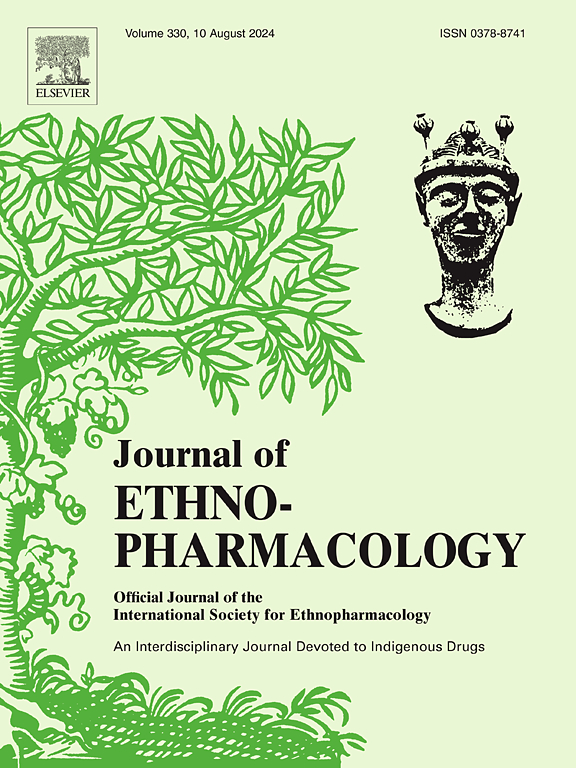Inhibition of oxidative stress contributes to the protective effect of Herba Siegesbeckiae on ischemic stroke by PI3K/STAT3/FOXO3a signal axis
IF 4.8
2区 医学
Q1 CHEMISTRY, MEDICINAL
引用次数: 0
Abstract
Ethnopharmacological relevance
Herba Siegesbeckiae (HS), well-recognized among the commonly used traditional medicines, is popular as one of the in-clinic treatments for rheumatoid arthritis, ischemic stroke, paralysis, asthma, and allergic disorders. However, the underlying mechanisms of neuroprotection and the part played by HS in protection against neuronal apoptosis continue to be nebulous.
Aim of the study
This study aims to explore whether HS can alleviate cerebral ischemic injury by protecting neurons and alleviating oxidative stress injury, and to elucidate the molecular mechanisms involved in PI3K/STAT3/FOXO3a signal pathway.
Methods
In this study, both in vitro and in vivo experiments were performed to examine the neuroprotective effects of HS on oxidative stress injury and neuronal apoptosis. After the HS treatment, several assays were done to assess the neuroprotection, oxidative stress response, and neuronal apoptosis. Besides, to further clarify the role of HS on the PI3K/STAT3/FOXO3a signal pathway, the effects of combining the HS with an inhibitor, agonist, or siRNA were studied.
Results
From the in vivo and in vitro experiments, it was evident that HS inhibited neuronal apoptosis to a significant degree and offered effective protection against oxidative stress injury by lowering the concentration of the reactive oxygen species (ROS), malondialdehyde (MDA), superoxide dismutase (SOD) and glutathione (GSH). Moreover, HS obviously up-regulated the principal proteins expression of the PI3K/STAT3/FOXO3a signal pathway, including the PI3K, p-Akt/Akt, and p-FOXO3a/FOXO3a. Additionally, HS reduced the fluorescence intensity of the STAT3 and FOXO3a, and advanced their nuclear translocation both in the in vitro and in vivo models. Nevertheless, after the combined treatment with HS and LY294002, Colivelin or siRNA-FOXO3a, these effects were reversed.
Conclusions
The present study gives pharmacological evidence, revealing that HS wields its protective actions by regulating the PI3K/STAT3/FOXO3a signal pathway, thus inhibiting oxidative stress injury and protecting the neurons from oxidative stress-generated damage. The current study emphasizes the potential of HS as a therapeutic means of treatment of oxidative stress conditions related to ischemic stroke.

民族药理学相关性诃子(Herba Siegesbeckiae,HS)是公认的常用传统药物,是治疗类风湿性关节炎、缺血性中风、瘫痪、哮喘和过敏性疾病的常用药物之一。研究目的本研究旨在探讨 HS 能否通过保护神经元和减轻氧化应激损伤来减轻脑缺血损伤,并阐明 PI3K/STAT3/FOXO3a 信号通路的分子机制。方法 本研究通过体外和体内实验研究 HS 对氧化应激损伤和神经元凋亡的神经保护作用。在 HS 处理后,对神经保护作用、氧化应激反应和神经元凋亡进行了多项评估。此外,为了进一步阐明 HS 对 PI3K/STAT3/FOXO3a 信号通路的作用,还研究了 HS 与抑制剂、激动剂或 siRNA 结合使用的效果。结果从体内和体外实验可以看出,HS能显著抑制神经元凋亡,并通过降低活性氧(ROS)、丙二醛(MDA)、超氧化物歧化酶(SOD)和谷胱甘肽(GSH)的浓度,有效保护神经元免受氧化应激损伤。此外,HS 还能明显上调 PI3K/STAT3/FOXO3a 信号通路主要蛋白的表达,包括 PI3K、p-Akt/Akt 和 p-FOXO3a/FOXO3a。此外,在体外和体内模型中,HS还能降低STAT3和FOXO3a的荧光强度,并促进它们的核转位。本研究提供的药理学证据显示,HS 通过调节 PI3K/STAT3/FOXO3a 信号通路发挥保护作用,从而抑制氧化应激损伤,保护神经元免受氧化应激损伤。本研究强调了 HS 作为缺血性中风相关氧化应激条件治疗手段的潜力。
本文章由计算机程序翻译,如有差异,请以英文原文为准。
求助全文
约1分钟内获得全文
求助全文
来源期刊

Journal of ethnopharmacology
医学-全科医学与补充医学
CiteScore
10.30
自引率
5.60%
发文量
967
审稿时长
77 days
期刊介绍:
The Journal of Ethnopharmacology is dedicated to the exchange of information and understandings about people''s use of plants, fungi, animals, microorganisms and minerals and their biological and pharmacological effects based on the principles established through international conventions. Early people confronted with illness and disease, discovered a wealth of useful therapeutic agents in the plant and animal kingdoms. The empirical knowledge of these medicinal substances and their toxic potential was passed on by oral tradition and sometimes recorded in herbals and other texts on materia medica. Many valuable drugs of today (e.g., atropine, ephedrine, tubocurarine, digoxin, reserpine) came into use through the study of indigenous remedies. Chemists continue to use plant-derived drugs (e.g., morphine, taxol, physostigmine, quinidine, emetine) as prototypes in their attempts to develop more effective and less toxic medicinals.
 求助内容:
求助内容: 应助结果提醒方式:
应助结果提醒方式:


